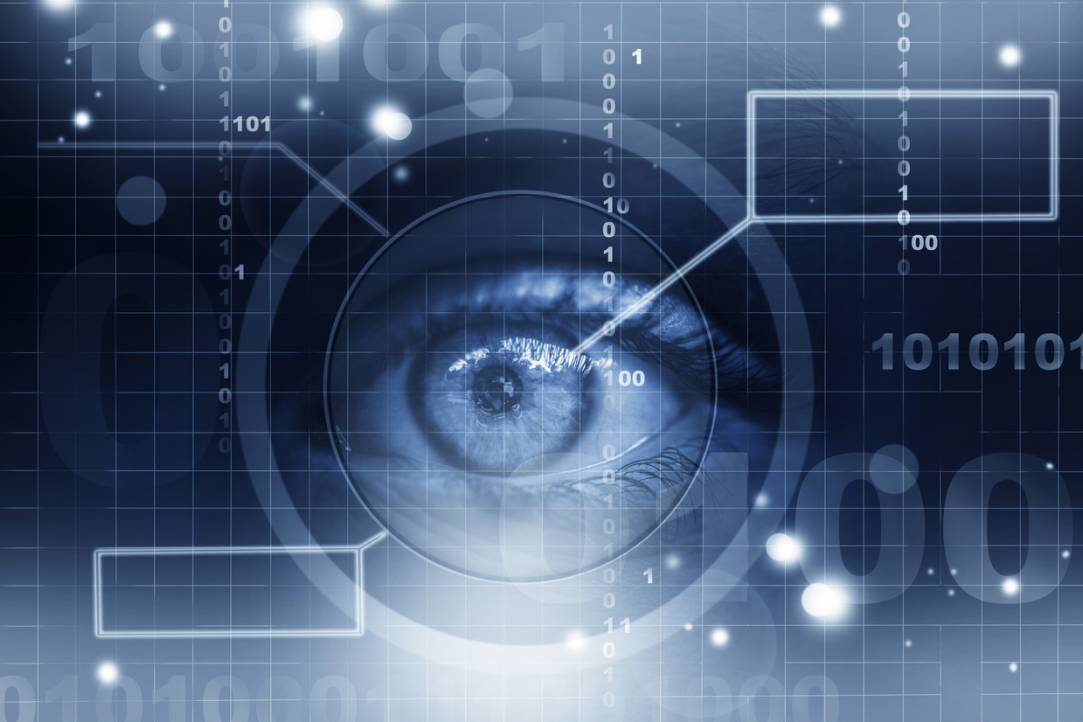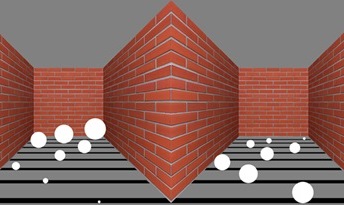‘In the Blink of an Eye’ Statistics: People Estimate Size of the Set of Objects Based on Distance to Them

HSE University researchers Yuri Markov and Natalia Tiurina discovered that when people visually estimate the size of objects, they are also able to consider their distance from the observer, even if there are many such objects. The observers rely not only on the objects’ retinal representation, but also on the surrounding context. The paper was published in the journal Acta Psychologica.
Multiple studies in visual ‘ensemble statistics’ have proven that humans are able to visually estimate the statistical characteristics of multiple objects in a fast and rather precise manner. As an observer fixes the eye on a group of objects for a split second, they can estimate both the simple features of this set (mean size of set of circles) and the complex ones (mean emotion of people in the photo or mean price of a group of goods).

One feature that is most often looked in such studies is the size of objects. But in laboratory conditions, objects are displayed on a flat screen, while in real life, objects have a certain context, which, among other things, can characterize the distance from the observer.
There are two different representations of size in the visual system: ‘retinal size’ – the physical projection of an object on the retina, and ‘perceived size’ – the rescaled size of objects taking into account the distance to them. For example, the retinal sizes of two cups of tea placed at different distances from the observer will be different. Meanwhile, their perceived sizes will be the same, since we know that the reason for the difference in size is the distance rather than the difference between the cups.
It is still unknown what size is used to estimate the statistical features of an ensemble – ‘retinal’ or ‘perceived’. In other words, is the visual system able to rescale the sizes of an ensemble of objects considering the distance before estimating their mean size?
To investigate this, the researchers carried out experiments with objects displayed at different depths. In the first experiment, the researchers demonstrated objects at different depths using a stereoscope – a device that uses mirrors to deliver images in different eyes with a small shift, which provides depth to the images (similar technology is used at 3D cinemas).
The second experiment used the Ponzo illusion, which also allows depth to be manipulated.

In both experiments, the scholars demonstrated differently sized objects at different depths and asked the respondents to estimate the variance of objects on the screen. In some samples, small objects were closer and big ones farther (positive size-distance correlation), while in the other samples it was the opposite (negative correlation).

Left: sample with positive size-distance correlation; right: sample with negative correlation. It may seem that size variance on the left is higher than on the right, but in fact, the circles have the same sizes in both pictures.
If ‘retinal size’ is used to estimate the variance in circle sizes, there will be no difference in answers to positive-correlation and negative-correlation samples. But if ‘perceived size’ is used for estimation, the circles in positive correlation (such as on the left picture) will be seen as those having higher variance due to the Ponzo illusion effect.
The results of both experiments confirmed that estimation is made according to ‘perceived sizes’: the respondents stated that in samples with positive correlation, circles had higher variance of sizes as compared to those with negative correlation.
These results prove that the visual system is able to estimate statistical characteristics of ensemble of objects quickly and automatically after rescaling them according to the distance.
Yury Markov, Research Assistant at the Laboratory for Cognitive Research, doctoral student of the School of Psychology (Faculty of Social Sciences)

It seems that object rescaling by their distance happens very fast and very early in the visual system,’ commented Yuri Markov, one of the study’s authors. ‘The information on the image is processed in high-level brain structures and, with the use of top-down feedback, regulates the activity of neurons responsible for object size assessment at earlier stages of processing. Only after that ensemble summary statistics are calculated.
In addition to fundamental academic value, this conclusion can also help in better designing complicated VR/AR environments where the information may be presented for the user at varied distances.
Yury Markov
Natalia Tiurina
See also:
Scientists Uncover Why Consumers Are Reluctant to Pay for Sugar-Free Products
Researchers at the HSE Institute for Cognitive Neuroscience have investigated how 'sugar-free' labelling affects consumers’ willingness to pay for such products. It was found that the label has little impact on the products’ appeal due to a trade-off between sweetness and healthiness: on the one hand, the label can deter consumers by implying an inferior taste, while on the other, it signals potential health benefits. The study findings have been published in Frontiers in Nutrition.
Internal Clock: How Heart Rate and Emotions Shape Our Perception of Time
Our perception of time depends on heart rate—this is the conclusion reached by neuroscientists at HSE University. In their experiment, volunteers watched short videos designed to evoke specific emotions and estimated each video's duration, while researchers recorded their heart activity using ECG. The study found that the slower a participant's heart rate, the shorter they perceived the video to be—especially when watching unpleasant content. The study has been published in Frontiers in Psychology.
Scientists Identify Personality Traits That Help Schoolchildren Succeed Academically
Economists from HSE University and the Southern Federal University have found that personality traits such as conscientiousness and open-mindedness help schoolchildren improve their academic performance. The study, conducted across seven countries, was the first large-scale international analysis of the impact of character traits on the academic achievement of 10 and 15-year-olds. The findings have been published in the International Journal of Educational Research.
Scientists Develop New Method to Detect Motor Disorders Using 3D Objects
Researchers at HSE University have developed a new methodological approach to studying motor planning and execution. By using 3D-printed objects and an infrared tracking system, they demonstrated that the brain initiates the planning process even before movement begins. This approach may eventually aid in the assessment and treatment of patients with neurodegenerative diseases such as Parkinson’s. The paper has been published in Frontiers in Human Neuroscience.
HSE Scientists Test New Method to Investigate Mechanisms of New Word Acquisition
Researchers at the HSE Centre for Language and Brain were among the first to use transcranial alternating current stimulation to investigate whether it can influence the acquisition of new words. Although the authors of the experiment have not yet found a link between brain stimulation and word acquisition, they believe that adjusting the stimulation parameters may yield different results in the future. The study has been published in Language, Cognition and Neuroscience.
When Thoughts Become Movement: How Brain–Computer Interfaces Are Transforming Medicine and Daily Life
At the dawn of the 21st century, humans are increasingly becoming not just observers, but active participants in the technological revolution. Among the breakthroughs with the potential to change the lives of millions, brain–computer interfaces (BCIs)—systems that connect the brain to external devices—hold a special place. These technologies were the focal point of the spring International School ‘A New Generation of Neurointerfaces,’ which took place at HSE University.
How the Brain Responds to Prices: Scientists Discover Neural Marker for Price Perception
Russian scientists have discovered how the brain makes purchasing decisions. Using electroencephalography (EEG) and magnetoencephalography (MEG), researchers found that the brain responds almost instantly when a product's price deviates from expectations. This response engages brain regions involved in evaluating rewards and learning from past decisions. Thus, perceiving a product's value is not merely a conscious choice but also a function of automatic cognitive mechanisms. The results have been published in Frontiers in Human Neuroscience.
Electrical Brain Stimulation Helps Memorise New Words
A team of researchers at HSE University, in collaboration with scientists from Russian and foreign universities, has investigated the impact of electrical brain stimulation on learning new words. The experiment shows that direct current stimulation of language centres—Broca's and Wernicke's areas—can improve and speed up the memorisation of new words. The findings have been published in Neurobiology of Learning and Memory.
HSE Researchers Discover Simple and Reliable Way to Understand How People Perceive Taste
A team of scientists from the HSE Centre for Cognition & Decision Making has studied how food flavours affect brain activity, facial muscles, and emotions. Using near-infrared spectroscopy (fNIRS), they demonstrated that pleasant food activates brain areas associated with positive emotions, while neutral food stimulates regions linked to negative emotions and avoidance. This approach offers a simpler way to predict the market success of products and study eating disorders. The study was published in the journal Food Quality and Preference.
HSE Neurolinguists Create Russian Adaptation of Classic Verbal Memory Test
Researchers at the HSE Centre for Language and Brain and Psychiatric Hospital No. 1 Named after N.A. Alexeev have developed a Russian-language adaptation of the Rey Auditory Verbal Learning Test. This classic neuropsychological test evaluates various aspects of auditory verbal memory in adults and is widely used in both clinical diagnostics and research. The study findings have been published in The Clinical Neuropsychologist.


